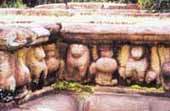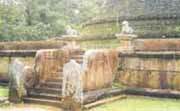| Plus |
|
|||||
|
History and
wilderness on road to East As such, in February we decided to take a trip on the A4 route which leads to the eastern shores of Pottuvil. Looking for travelling companions was difficult in those early months of the ceasefire when people were still wary about travelling to the eastern quarter of our island.
I phoned many of our friends who could not make up their mind to join us. Ultimately we found two equally adventurous friends and left Colombo. Our first stop was at the Belihul Oya Rest House for a hot cup of tea and then Koslanda to enjoy a hearty breakfast watching the handsome Diyaluma waterfall changing colours and shape in tune to the dimpling of the morning sun and breeze. We proceeded on the A4 passing Wellawaya, Buttala and reaching Moneragala. We stopped again to enjoy a cup of tea at the Monaragala Rest house and after topping up on fuel, reached Siyambalanduwa around 2.00 p.m. From there taking the less obvious road east, we continued along the A4 towards the eastern shores of Pottuvil. However unlike the A9, the road was comparatively comfortable and there were no checkpoints.
But like on the A9, boutique fronts exhibited bottles of kerosene for sale. The landscape began to change dramatically and the humble homes with their chena cultivations gave way and jungle on either side of the road increased. At Lahugala we were travelling through one of Sri Lanka's enchanted jungles, also a national park. The narrowing A4 wound its way through tall trees entwined with typical jungle creepers and sometimes bursting into lime-green beru grass fields of the twin tanks of Mahawewa and Kitulana. It is said that this is the likeliest place to find wild elephants right through the day and we were not disappointed to see in the distance a herd of elephants feasting on beru grass, while two youngsters played lovingly with their trunks entwined. Even though a jeep track could be seen leading towards where the elephants grazed, where maybe we could have seen them closer, we decided against disturbing these majestic giants who seemed so much more at home than the elephants we had seen at other national parks in the island. We watched them through our 'binos' and photographed them, enjoying their antics for almost an hour. The sealed road through the park minimized the dust and the jungle cover all around us echoed with the call of birds. It was peaceful, natural and beautiful. This area was still not littered with "siri siri" bags or crowded with noisy over-enthusiastic travellers, on a hunt to see the elephant. It was almost 4.00 p.m. when we decided to have our lunch sitting on the steps of the remnants of a building which was ridden with bullet holes. Proceeding further east on the A4, we came across an Archaeological Department board indicating the Magul Maha Viharaya. A short distance south on an unsealed road, and then along a foot path in a jungle clearing, we came to this complex of ancient and forgotten ruins. We were told that the earliest date that can be attributed to this site is the Second Century BC. However it was easy to see from the varied decorative stone work and buildings in this complex that the ruins may date from different periods of history. Characteristic of an earlier era in history, the stone entrances to the "dagoba" were flanked by simple guardstones with a projection at the centre of the top and an elegant balustrade conforming to geometrical lines. In contrast, a later era and a development of the guardstone was evident in the decorative guardstones of the "yak sa" figures of Sankha and Padma with the symbol of the conch and the lotus, flanking the entrances to a pavilion. Similar guard stones of Sanka and Padma have been found at Anuradhapura in Abhayagiri Stupa and Vijayabahu Palace. The site is well demarcated with stone walls and entrances. Amongst the ruins that have been identified are a "pokuna", "mal asana", "pilima ge", "poya ge", "bodhighara", "dagoba" and "magul mandapaya". The "magul
madapaya" is of special significance as it is said that it
is here that the marriage ceremony of queen Viharamaha devi to King
Kavantissa took place. Also found in the complex is a moonstone with a design of elephants running from left to right. We were informed that similar designed moonstones may also be found at the ancient sites of Oggamuwa in Matale and Hatthikucchi vihara in Rajangana. The figure of a man riding on the back of one of the elephants makes this moonstone one of its kind in Sri Lanka. This fact was later confirmed by the Archaeological Department in Colombo. Two slab inscriptions found on this site have been published in the Epigraphia Zeylanica. It was heartening to see that the site was well looked after by two employees of the Archaeology Department (one of whom sported a cowboy style hat)who were enthusiastic to show us around the site and relate the history and legend surrounding this interesting jungle complex, surrounded by wild life, birds and butterflies. We were told that there were crocodiles in and around the ancient "pokuna" and often elephants would come by. It was time to proceed further east on the A4 towards our destination. The scenery once again began to change from jungle to almost surprisingly flat grass plains and green paddy fields over which appeared the eastern sky marked by a few palmyrah trees as we approached Pottuvil. We turned south towards delightful Arugam Bay and a piping hot dinner of spaghetti, cheese and prawns. |
||||||
Copyright © 2001 Wijeya Newspapers
Ltd. All rights reserved. |

